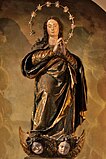Alonso Cano

Alonzo Cano or Alonso Cano (19 March 1601 – 3 September 1667) was a Spanish painter, architect and sculptor born in Granada.[1]
Biography

He learned architecture from his father, Miguel Cano;[1] painting in the academy of Juan del Castillo,[1] and from Francisco Pacheco the teacher of Velázquez; and sculpture from Juan Martínez Montañés. As a sculptor, his most famous works are the Madonna and Child in the church of Lebrija (also called Nebrija), and the colossal figures of San Pedro and San Pablo.[1][2]
He was made first royal architect, painter to Philip IV, and instructor to the prince, Balthasar Charles, Prince of Asturias. The King gave him the church preferment of a canon of the Granada Cathedral (1652),[1] in order to take up a position as chief architect of the cathedral, where his main achievement in architecture was the façade, designed at the end of his life and erected to his design after his death.[citation needed]
He was notorious for his ungovernable temper; and it is said that once he risked his life by committing the then capital offence of dashing to pieces the statue of a saint, when in a rage with the purchaser who begrudged the price he demanded.[2][1] According to another story, he found his house robbed after coming home one evening, his wife murdered, and his Italian servant fled. Notwithstanding the presumption against the fugitive, the magistrates condemned Cano, because he was of a jealous temper.[3] Upon this he fled to Valencia, but afterwards returned to Madrid, where he was put to the torture, which he endured without incriminating himself, and the king received him into favour.[4]
After the death of his wife he took Holy Orders[1] as a protection from farther prosecution, but still continued his professional pursuits. He died in 1667. In his last moments, when the priest held to him a crucifix, he told him to take it away; according to the Catholic Encyclopedia, this was because the priest gave the Sacrament to conversos.[1] Probably this version is spurious as many others about his life and temperament.
Works
- San Vicente Ferrer (praying)
- Virgin of the Olive Tree (1629)
- Inmaculada del Facistol (1655–1656) in the sacristy of the Cathedral of Granada.
- Virgen of Bethlehem
- Bust of Saint Paul
- Head of San Juan de Dios
- Annunciation
- Christ Bound to the Column in the church of the Convento del Stmo. Cristo de la Victoria de Serradilla (Cáceres).
- Entrance of the Cathedral of Granada
- Saint John the Baptist as a Youth 1634, in the National Sculpture Museum (Valladolid).
- "St. Anthony Preaching to the Fish" (1630) [Detroit Institute of Arts]
Gallery
-
Immaculate Conception, c. 1618–20, attributed to Velázquez or Cano
-
Saint John and the Poisoned Chalice, c. 1635–37
-
Cristo y la Sama, Christ and the Samaritan woman, 1640
-
Christ Gathering his Robes, 1646
-
Cristo crucificado, Christ on the cross, 1646
-
Christ and Two Followers on the Road to Emmaus, between 1635 and 1650
-
Ideal portrait of a Spanish King, 1643
-
St. Vincent Ferrer Preaching, c. 1644–45
-
Saint Bernard, c. 1656–60
-
Antony of Padua, 1660–62
-
Immaculate Conception
-
Saint John the Baptist
External links
- Paintings of Alonzo Cano on Insecula
- Alonso Cano on Artcyclopedia
- Jusepe de Ribera, 1591-1652, a full text exhibition catalog from The Metropolitan Museum of Art, which includes material on Alonso Cano (see index)
References
- ^ a b c d e f g h Alonso Cano – Catholic Encyclopedia article
- ^ a b One or more of the preceding sentences incorporates text from a publication now in the public domain: Chisholm, Hugh, ed. (1911). "Cano, Alonzo". Encyclopædia Britannica. Vol. 5 (11th ed.). Cambridge University Press. p. 189.
- ^ Chisholm 1911.
- ^ Anonymous, "Alonso Cano" in Retratos de Españoles ilustres con un epítome de sus vidas, 1791.
 This article incorporates text from a publication now in the public domain: Herbermann, Charles, ed. (1913). "Alonso Cano". Catholic Encyclopedia. New York: Robert Appleton Company.
This article incorporates text from a publication now in the public domain: Herbermann, Charles, ed. (1913). "Alonso Cano". Catholic Encyclopedia. New York: Robert Appleton Company.












